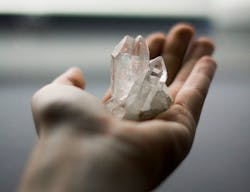Download this article in PDF format.
Oven-controlled crystal oscillators (OCXOs) and temperature-compensated crystal oscillators (TCXOs) are often confused—and for good reason. From a layman’s perspective, both “oven-controlled” and “temperature-compensated” imply the use of heat or temperature to help control the frequency output of a crystal oscillator.
While this may be true, quite a few characteristic differences exist between OCXOs and TCXOs. In this article, we’ll discuss OCXOs and TCXOs and what makes them different from each other. We’ll also get into the common application uses for each type.
Oven-Controlled Crystal Oscillators (OCXOs)
OCXOs are used in applications that require a very high degree of frequency stability. Sometimes these oscillators may even be referred to as temperature-stabilized crystal oscillators, or simply crystal ovens. Just don’t get excited about cooking any pizzas in this type of oven.
While crystal oscillators, of which there are three main types, show a high degree of stability even when the outside temperature is varied over a significant range, some applications require even higher levels of temperature stability. In these applications, OCXOs may provide the required solution.
Quartz crystals such as these are cut to ensure that temperature stability is optimized for the OCXO’s internal operating temperature.
The Power to Control Temperature
It’s still sometimes necessary to ensure an even better degree of stability. This can be achieved by placing the crystal in a thermally insulated container with a thermostatically controlled heater.
By heating the crystal to a temperature above that which would normally be encountered within the electronic equipment, the crystal’s temperature can be maintained at a constant temperature. This results in a far greater degree of temperature stability. Additionally, the crystal in the OCXO will be cut to ensure that its temperature stability is optimized for the internal operating temperature (see figure).
The internal temperature for a crystal oven is commonly run at about 75°C. It needs to be above the highest temperature likely to be encountered, or else the temperature control will not work.
The typical specification for an OCXO might be ±5 × 10−8 per degree Celsius (0.05 ppm). A non-oven-controlled oscillator, on the other hand, may be between 10 and 100 times poorer.
To ensure that the optimum overall accuracy is maintained, combating elements such as aging of the crystal itself may be required as well as a periodic calibration of the OCXO. Typical calibration periods may be on the order of six months to a year, but the actual period will depend on the OCXO itself and the requirements of the application in which it is being used.
More Physical Abilities of an OCXO
OCXOs are physically much larger than a simple crystal oscillator. This is because they:
- Incorporate the crystal oscillator itself
- Contain a heater
- Contain control circuitry
- House thermal insulation around the crystal oscillator
Typically, the heater will run from a different supply to the oscillator. The supply for the OCXO’s heater may be quite current-hungry. Some units may require an amp or so upon warm-up. This figure will reduce as the temperature inside the OCXO rises and less heat is needed. As you might imagine, the temperature is thermostatically controlled.
Temperature-Compensated Crystal Oscillators (TCXOs)
A standard TCXO has quite a few performance qualities and can even completely solve the two major problems with quartz crystals. Here are some of the most common performance characteristics of TCXOs:
TCXO PPM performance: The TCXO temperature performance is better than that of a normal crystal oscillator. Figures of between 10 and 40 times improvement can often be seen. Figures of better than ±1.5 ppm over a 0 to 70°C temperature range are difficult to achieve, though. That’s because they fall into a high-precision category, where costs increase significantly.
Power dissipation: The power dissipation of a TCXO will be greater than an ordinary oscillator due to the additional circuitry required. In addition, the cost is greater. One should also remember that it takes a short while after startup for the oscillator to stabilize (and hopefully stay stabilized). This may be on the order of 100 ms, or possibly longer, depending on the design.
TCXO package: TCXOs come in a variety of packages, depending on the way they have been designed and the requirements of the end user. The most common form of construction is to build the circuit on a small printed circuit board (PCB) that can be housed in a plated metal package. This then becomes suitable for mounting onto the main circuit board of the overall equipment. Since the crystal itself is sealed, this means that sealing of the overall TCXO package is not critical, or even required for most applications.
Note: Package sizes such as 5 × 3.2 × 1.5 mm or 5 × 3.5 × 1 mm are widely used for TCXOs; smaller packages are available if required.
Output format and level: With many TCXOs being used to drive digital circuits, most of the small oscillator packages produce what is termed a clipped sine wave. This is suitable for driving a logic circuit, although in many cases it’s wise to put it through a logic buffer to ensure it’s sufficiently square. Often the output is an open collector circuit. If a sine wave output is required, this must be chosen at the outset; it will limit the choice available.
Power requirements: Actual power requirements will be predicated on the device. Many operate from supplies of 3 V and may draw as little as 2 mA, although this will depend on the general type, the manufacturer, and the particular device chosen.
4 Common Types of TCXOs
Although TCXOs are normally referred to in this manner, occasionally more detailed descriptions are used. Consequently, a variety of techniques can be used to provide the temperature compensation.
ADTCXO: This is an analog digital TCXO, widely used in cell phones. ADTCXOs leverage analog technology to provide temperature correction to the oscillator. It has the advantage that changes take place slowly and no phase jumps are experienced, as is the case with some all-digital types.
DTCXO: As you probably surmised, this is a digital TCXO. A DTCXO begins with a temperature sensor. Logic and mathematical functions use digital circuitry along with a lookup table. The resulting digital correction figure is converted to an analog signal using a digital-to-analog converter (DAC).
DCXO: This is a form of oscillator where any correction is calculated by the host processor within the equipment. In this way, the TCXO is not a separate entity, but the processing is incorporated within that of the overall equipment. This can help save costs in some instances.
MCXO: This form of TCXO uses a microprocessor to provide a considerably increased level of processing to deliver more accurate compensation under a variety of circumstances. While performance is a little better, costs are above those of the other forms.
TCXOs are widely used where accurate frequency sources are needed. They are less expensive and smaller than OCXOs. As such, they offer an ideal solution for many portable units requiring a reasonably accurate source.
To read more on common misconceptions about crystal oscillator stability, click here.


